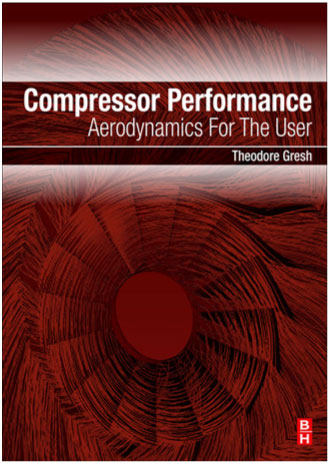
There are a number of books available in the area of compressor design and aerodynamics, but there are few aimed at the more practical aspects such as selection, operation, field testing, troubleshooting or that provide such a wider scope.
This book is now in its Third edition, and its scope is such that is divided into three sections – theory, application and reference materials, including gas properties and Mollier diagrams for many of the most common fluids requiring compression systems. The inclusion of such diagrams and information is important because, of course, the performance of a compression system cannot be obtained without such information.
The theory section of the book starts with an historical perspective of the development of compressors and then goes on to describe the positive displacement, axial and radial compressors, along with definitions of the primary design parameters for each. The thermodynamic relations or compressors are mostly just stated, and it is expected that the reader will already have a reasonable grounding in the basics of thermodynamics, so this section in sensibly in summary form and all the more useful for it. This section also includes a section on the measurement of mass flow rates, the non-dimensional performance parameters used in the design and evaluation of compressor performance. Other chapters in Part I include information on axial and radial compressors and their aerodynamics, velocity triangles, performance characteristics and off-design operation with clear descriptions throughout. Part I, while brief, is a comprehensive and detailed summary and covers a significant amount of useful information for practicing engineers but particularly engineering students.
Part II of this book is where it really comes into its own. This concerns compressor applications and areas such as equipment selection (for example, axial radial or mixed flow compressors for various duties) as well as compressor operation and field performance testing. This information is complemented by example calculations. Significant space is devoted to the operation of compressors including start-up procedures, effect of environmental conditions, part and full load conditions and, where appropriate, the pipework and machinery upstream of the compressor inlet and its effect on the compressor. This is taken even further, later in the chapter, when methods of field testing are described including trend analysis through continuous monitoring. Such analysis can be difficult due to changes in gasses being compressed and the operating point of the compressor, but analysis options are carefully explained through use of example calculations.
The latter chapters of Part II are devoted to multi-section compressors, which goes into a great deal of depth in this area with industry data and example calculations. The chapter on compressor string analysis illustrates that equipment drivers and plant system can dramatically affect the compressor performance. In other words, sometimes it is not the compressor performance that is actually the issue, but other systems around it. Linked to this chapter is information on troubleshooting compressor performance, which comes from the experience of the authors many years working in the area and so is driven again by real-world application. The measurement of mass flows using orifice plates and pitot tubes is also covered in sufficient details for most compressor applications.
Part III concerns the reference material and is comprehensive containing over 30 pages of Mollier charts for different gasses from steam, air and ammonia, to helium and propylene, amongst many more.
The book is written in an exceptionally clear manner that will be accessible to all. A sensible mix of theoretical modelling is included where appropriate but always backed up by clear explanations, diagrams and examples. There are numerous example calculations through the book to help designers get to the fundamentals of the subject in question. As a result, the book is of interest to both design and maintenance engineers as well as students.
My only real criticism of the book is that it continues, like the industry of course, to adhere to English units!




